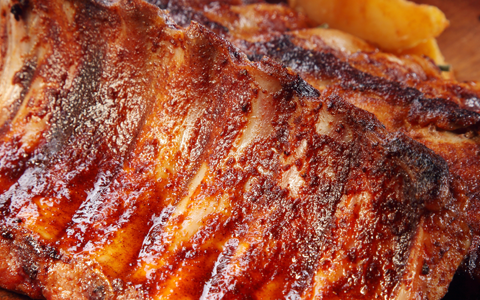Grilled Ribs – Secrets for Perfect Results
Romania’s king of the grill? Pork, without question. Elected by the hungry public and re-elected every summer for at least a 3-month term on every barbecue. Its success is no accident—its campaign promises are always delivered: unbeatable flavor, tenderness, and juiciness. Not to mention, it’s backed by an unbeatable team of experts like sausages, mici, and hot dogs ready to hit the grill for you.
We all know pork most commonly appears on the grill as belly, neck, loin, sausages, or mici. Although everyone dreams of them, pork ribs are often left to the chefs in restaurants. Maybe because they’re fussier to prepare, or not always available at the butcher. Or worst of all, because homemade ribs don’t turn out as tender and juicy as in restaurants. But we’re here to fix that—with 5 minutes of your time, we’ll give you 5 secrets for perfect grilled ribs.
First of all: There are 3 types of pork ribs!
- Baby back ribs – the upper section, near the spine. They’re smaller, curved, and less fatty → cook faster.
- Spare ribs – the lower section, under the baby backs. They’re longer, flatter, fattier → take longer to cook.
- “Scaricica” ribs – essentially spare ribs that still have plenty of meat on them (with just the skin removed).
Unfortunately, many Romanian butchers label spare ribs as “scaricica,” but we’ll chalk that up to a still-developing culinary vocabulary. Now, let’s get into the real tips for perfect ribs.
1. Remove the Membrane
This thin white skin on the underside of the ribs can get in the way of achieving fall-off-the-bone tenderness. Use a small sharp knife to lift one edge of the membrane, then pull it off carefully. Use a paper towel or dry cloth for better grip if it slips.
2. Pre-cook the Ribs Before Grilling
Why are restaurant ribs so tender and flavorful? It’s not about fancy grills or alien chefs—it’s about pre-cooking. Low and slow is the secret: bake them in the oven, simmer them in seasoned water, or use a slow cooker. The grill is just the grand finale, adding smoky aroma and irresistible color.
3. Sauce at the Right Time
Most BBQ sauces contain sweeteners like honey, brown sugar, maple syrup, or molasses. Delicious, but prone to burning if applied too early. Brush the sauce on about 10–15 minutes before finishing. That’s just enough time to glaze and caramelize without burning. If you’re using a dry rub, this step is optional.
4. Cook Them Just Right
Americans recommend grilling until the internal temperature reaches 62°C (about 145°F)—easy to check with a meat thermometer. But don’t rely solely on that. Learn to read the ribs: they’re done when the meat starts pulling back from the bones at the thinner ends. When picked up with tongs, the ribs should bend in the middle without falling apart.
5. Grill Low and Slow
High heat is perfect for quick items like burgers, hot dogs, or chicken breast. Ribs, however, need gentle cooking. High heat can dry them out or cook unevenly. Position them over lower heat zones on the grill for optimal tenderness. You can finish with a brief sear over high heat for color—but don’t leave them unattended!


